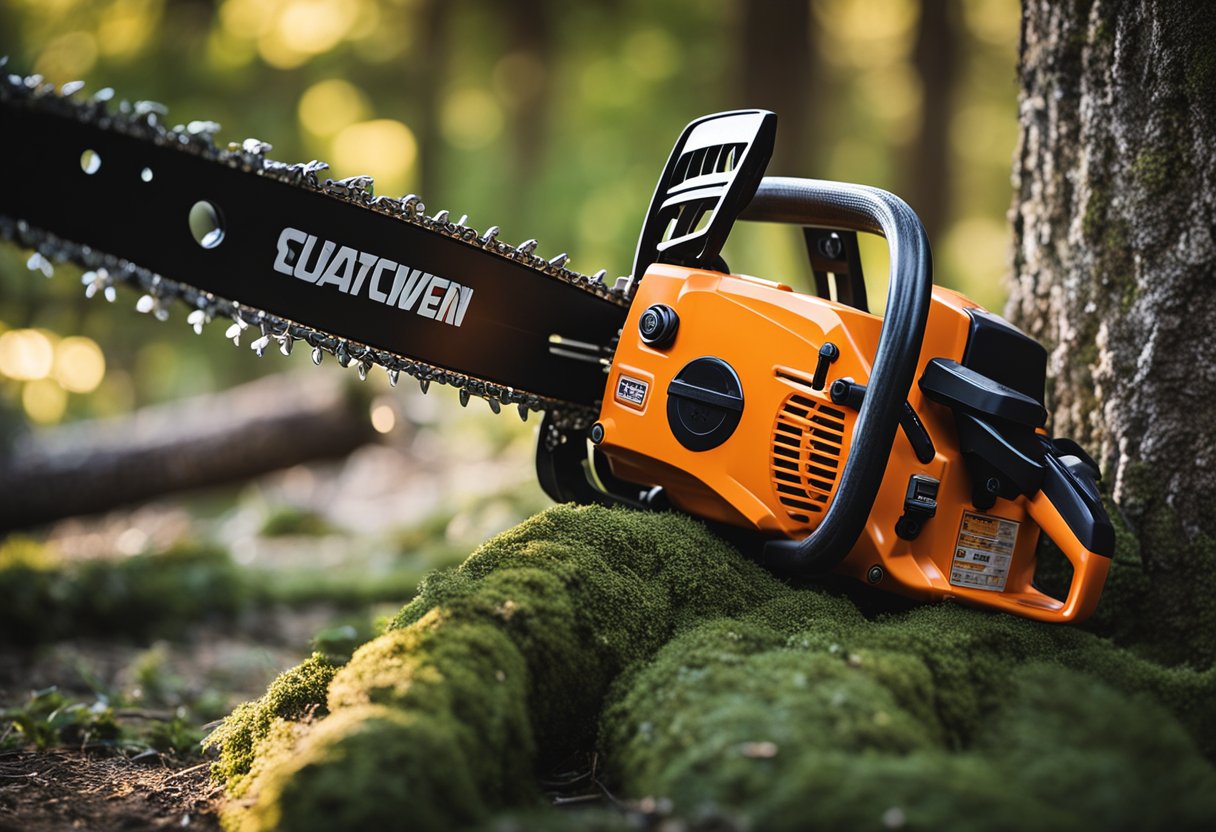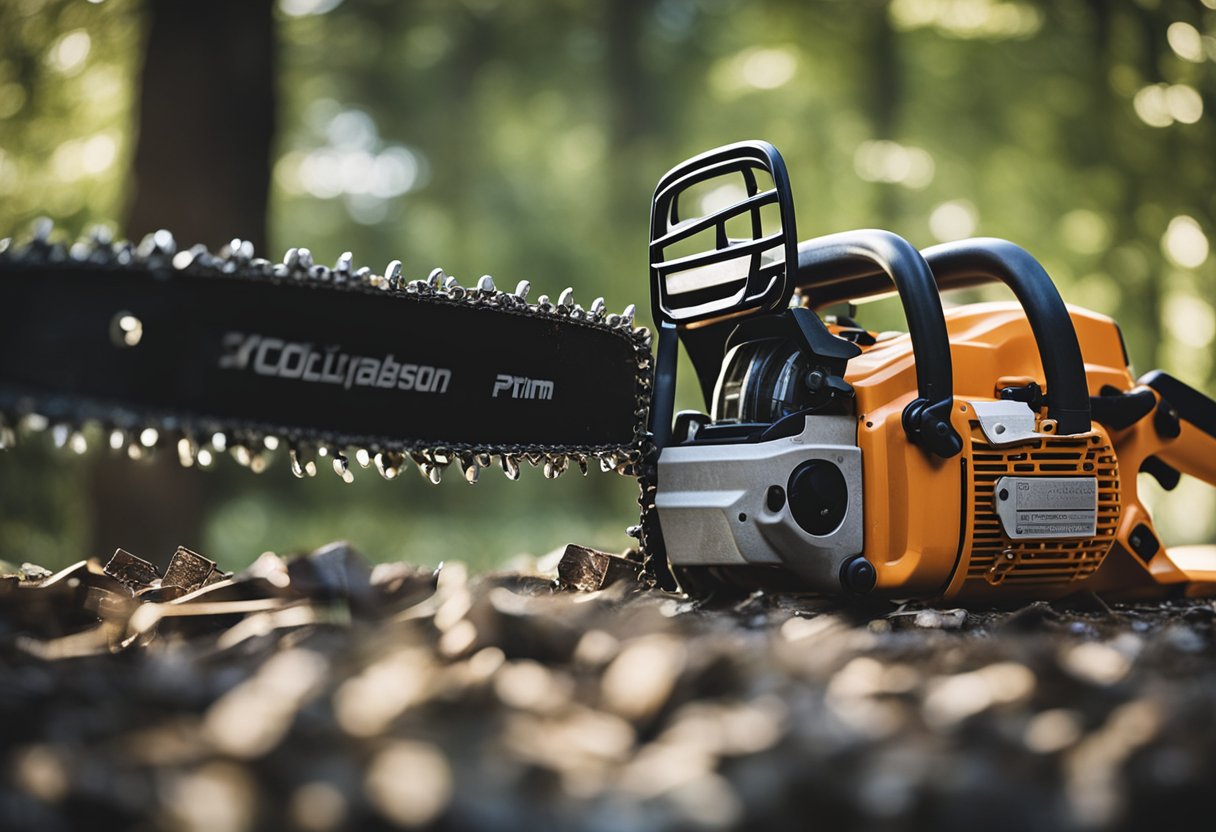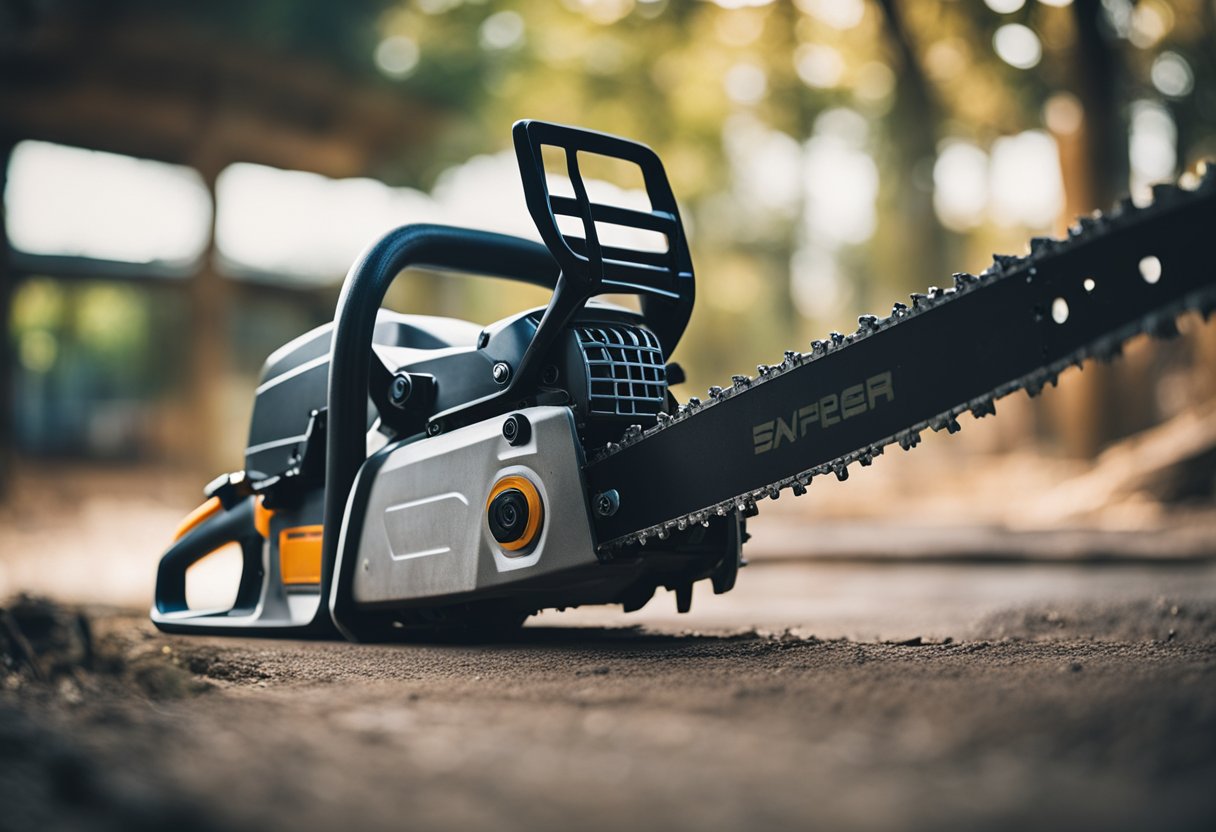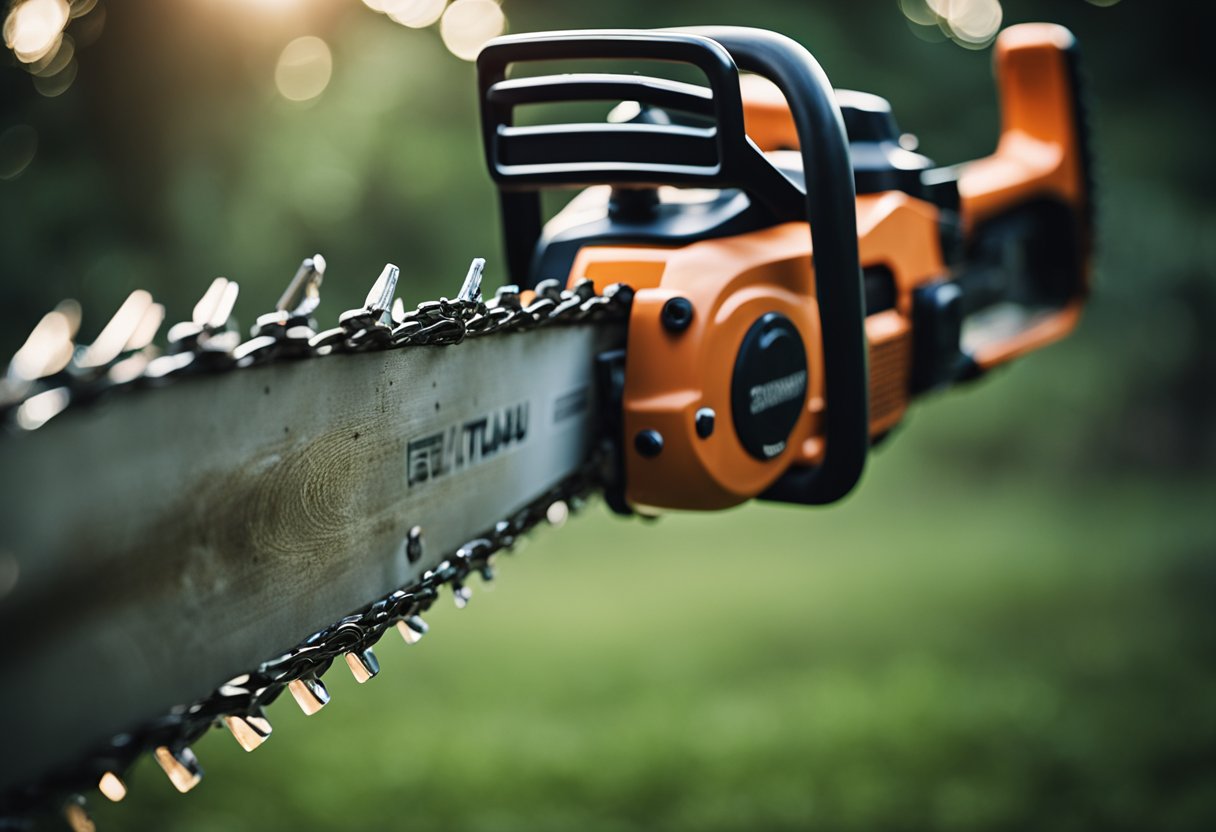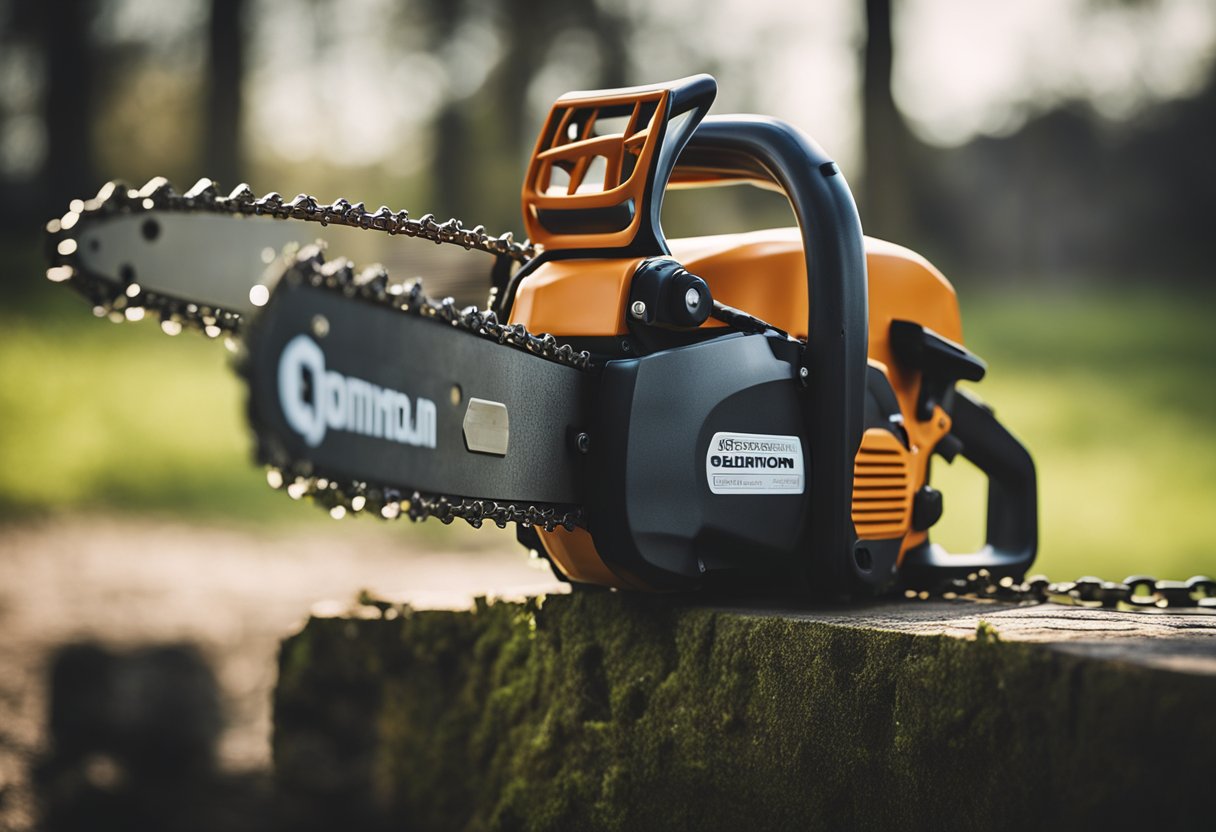If you’re a chainsaw user, you may have experienced the frustration of a chain that keeps coming off. Not only is it annoying, but it can also be dangerous. A chainsaw chain that comes off the bar can cause injury to the operator or bystanders. In this article, I will discuss the common reasons why chainsaw chains come off and how to fix them.
Understanding chainsaw chains is important when it comes to troubleshooting. Chainsaw chains consist of drive links, cutters, and tie straps. The drive links are the part of the chain that fits into the bar groove, while the cutters are the teeth that cut through the wood. The tie straps connect the cutters to the drive links. The chain is driven by the sprocket, which is attached to the chainsaw’s engine. The chain wraps around the bar, which is the long, flat metal piece that guides the chain through the wood. The Importance of Proper Chain Tension is also a key factor in keeping your chainsaw chain in place.
Understanding Chainsaw Chains
https://www.youtube.com/watch?v=iY-qgN6StuQ&embed=true
As a chainsaw user, it is important to understand the components of a chainsaw chain. A chainsaw chain is made up of several parts, including the drive links, chain pitch, and chain gauge. The drive links are the part of the chain that fits into the chainsaw’s guide bar. The chain pitch refers to the distance between the links, while the chain gauge refers to the thickness of the drive links.
The chainsaw chain is an essential part of the chainsaw, and it is important to choose the right chain for the job. The wrong chain can cause the chainsaw to malfunction and even cause injury. It is important to consider the type of wood you will be cutting, the size of the chainsaw, and the type of chainsaw you will be using when choosing a chainsaw chain.
When installing a chainsaw chain, it is important to ensure that it is properly tensioned. A loose chain can come off the bar, while an overly tight chain can cause damage to the chainsaw’s guide bar. It is important to follow the manufacturer’s instructions when adjusting the tension of the chainsaw chain.
In addition to proper tensioning, regular maintenance of the chainsaw chain is also important. This includes sharpening the chain and ensuring that it is properly lubricated. A dull chain can cause the chainsaw to work harder, while a dry chain can cause excessive wear and tear on the chainsaw’s guide bar.
Overall, understanding the components of a chainsaw chain and proper maintenance is essential for safe and efficient chainsaw operation.
The Importance of Proper Chain Tension
https://www.youtube.com/watch?v=FxgQSPQeYYM&embed=true
As a chainsaw user, I know the importance of proper chain tension. Proper tension ensures that the chainsaw chain runs smoothly and efficiently. Improper chain tension can cause the chain to come off the bar, leading to damage to the chainsaw and potential injury to the user.
To ensure proper tension, it is important to check the chainsaw chain tension before each use. This can be done by using a chainsaw chain tension tool or by manually checking the tension. The proper tension for a chainsaw chain is when the chain is snug against the bar, but still moves freely.
Incorrect chain tension can lead to a variety of issues. If the chain is too loose, it can come off the bar, causing damage to the chainsaw and potential injury to the user. If the chain is too tight, it can cause excessive wear on the chain and bar, leading to premature replacement of these parts.
Proper chain tensioning is a simple process that can be done by adjusting the tensioning screw on the chainsaw. It is important to follow the manufacturer’s instructions when adjusting the tension, as improper adjustment can lead to further issues.
In conclusion, proper chain tension is essential for the safe and efficient use of a chainsaw. By regularly checking the chain tension and properly tensioning the chainsaw chain, users can ensure that their chainsaw runs smoothly and efficiently, while minimizing the risk of damage and injury.
Identifying Common Problems
https://www.youtube.com/watch?v=akyMYBdEtkM&embed=true
As a chainsaw user, I have experienced the frustration of having my chainsaw chain come off mid-cut. This can be a safety hazard and can also damage the chainsaw if not addressed promptly. In this section, I will identify some of the common problems that can cause a chainsaw chain to come off and how to avoid them.
Loose Chain Tension
One of the most common reasons why a chainsaw chain comes off is due to loose chain tension. A loose chain can easily derail from the guide bar, causing the chain to come off. To avoid this, it is important to check the chain tension regularly and adjust it as needed. A loose chain can also cause damage to the chainsaw and guide bar, so it is important to address this issue promptly.
Wrong Size Chain
Using the wrong size chain can also cause the chainsaw chain to come off. It is important to use the correct chain size for your chainsaw model to prevent this issue. Using the wrong size chain can cause the chain to be too loose or too tight, which can lead to the chain coming off or breaking. Always refer to the chainsaw manual or consult with a professional to ensure you are using the correct chain size.
Bent Chain or Guide Bar
A bent chain or guide bar can also cause the chainsaw chain to come off. This can happen if the chainsaw hits a hard object, causing damage to the chain or guide bar. It is important to inspect the chain and guide bar regularly for any signs of damage. If you notice any bending or warping, it is best to replace the damaged part to prevent further issues.
Using the Wrong Size Chain
Using the wrong size chain can also cause the chainsaw chain to come off. It is important to use the correct chain size for your chainsaw model to prevent this issue. Using the wrong size chain can cause the chain to be too loose or too tight, which can lead to the chain coming off or breaking. Always refer to the chainsaw manual or consult with a professional to ensure you are using the correct chain size.
In summary, loose chain tension, using the wrong size chain, and bent chain or guide bar are some of the common problems that can cause the chainsaw chain to come off. By regularly inspecting the chainsaw and following proper maintenance procedures, you can avoid these issues and ensure safe and efficient operation of your chainsaw.
Inspecting and Maintaining Your Chainsaw
https://www.youtube.com/watch?v=NvCGoghPBWE&embed=true
As a chainsaw owner, it is important to regularly inspect and maintain your chainsaw to prevent the chain from coming off during operation. Here are some tips to help you keep your chainsaw in good working condition:
Check the Tension
One of the most common reasons why the chain comes off the chainsaw is due to improper tension. To prevent this, I always check the tension of the chainsaw chain before each use. I make sure that the chain is properly tensioned, with just enough slack to allow the chain to move freely around the bar. If the chain is too loose, it can easily come off during operation. On the other hand, if the chain is too tight, it can cause excessive wear and tear on the bar and chain, leading to premature failure.
Inspect the Guide Bar
The guide bar is another important component of the chainsaw that requires regular inspection and maintenance. I always check the guide bar to make sure it is level with the chain. If the guide bar is not level, it can cause the chain to come off during operation. Additionally, I inspect the guide bar for any signs of wear and tear, such as cracks or dents. If the guide bar is damaged, it should be replaced immediately.
Lubricate the Chain
Proper lubrication is essential to keep the chain running smoothly and prevent it from coming off the chainsaw. I always make sure to lubricate the chain before each use, using the appropriate oil recommended by the manufacturer. This helps to reduce friction and heat buildup, which can cause the chain to come off.
Inspect the Chain Brake
The chain brake is a safety feature that is designed to stop the chain from rotating in the event of kickback. I always inspect the chain brake to make sure it is functioning properly before each use. If the chain brake is not working properly, it can cause the chain to come off during operation, which can be dangerous.
Check the Spark Plug
Finally, I always check the spark plug before each use to make sure it is clean and in good condition. A dirty or damaged spark plug can cause the engine to misfire, which can lead to excessive vibration and cause the chain to come off. If the spark plug is dirty or damaged, it should be cleaned or replaced immediately.
By following these simple tips, you can help to prevent the chain from coming off your chainsaw during operation, ensuring safe and efficient use.
Troubleshooting and Repair
https://www.youtube.com/watch?v=zvr8JzL77jM&embed=true
If you’re having problems with your chainsaw chain coming off, there are a few things you can do to troubleshoot and repair the issue. Here are some steps you can take to fix the problem:
-
Check the chain tension: One of the most common reasons for a chainsaw chain to come off is improper chain tensioning. Ensure that the saw chain is properly tensioned, with just enough slack to allow the chain to move freely around the bar. Check the bar to make sure it is level with the chain. Adjust the bar and chain tension as needed.
-
Inspect the drive sprocket: If the drive sprocket is worn out, it can cause the chain to come off. Inspect the sprocket for wear and replace it if necessary.
-
Check the bar and bar heel: A worn-out bar or bar heel can also cause the chain to come off. Inspect the bar and heel for wear and replace them if necessary.
-
Inspect the chain tensioner screw: If the chain tensioner screw is disengaged or has stripped threads, it can cause the chain to come off. Inspect the screw and replace it if necessary.
-
Remove a chain link: If the chain is too loose, you can remove a link to tighten it. Use a chain breaker tool to remove the link, then reattach the chain.
If these steps don’t solve the problem, it may be time to take your chainsaw to a professional service/repairer. They can diagnose the issue and provide a long-term solution to keep your chainsaw chain from coming off in the future.
Remember to always wear protective gear when working with chainsaws, including eye and ear protection, gloves, and appropriate clothing.
Safety Measures
As a chainsaw user, I know that safety is paramount when using this powerful tool. The chainsaw chain coming off can be a safety hazard, and it is important to take the necessary measures to prevent accidents. Here are some safety measures that I recommend:
Protective Gear
It is important to wear protective gear when using a chainsaw. This includes a hard hat, eye protection, ear protection, gloves, and chainsaw chaps. Chainsaw chaps are designed to protect your legs in case the chainsaw chain comes off and hits you. They are made of a material that will stop the chainsaw chain from cutting through your clothing and into your skin.
Proper Maintenance
Regular maintenance of the chainsaw is essential to prevent the chainsaw chain from coming off. This includes checking the tension of the chain, inspecting the guide bar, and ensuring that the drive sprocket is in good condition. It is also important to keep the chainsaw clean and lubricated to prevent the chain from binding or overheating.
Safe Cutting Techniques
Using safe cutting techniques can also help prevent the chainsaw chain from coming off. This includes making sure that the chainsaw is properly positioned and that the chain is not pinched or bound in the wood. It is also important to use the correct cutting technique for the type of wood you are cutting.
In conclusion, preventing the chainsaw chain from coming off is essential for safety when using a chainsaw. By wearing protective gear, performing proper maintenance, and using safe cutting techniques, you can minimize the risk of accidents and injuries.
Optimizing Chainsaw Efficiency
As a chainsaw user, I understand the importance of maintaining my chainsaw to ensure optimal performance. One of the most common issues that can affect the efficiency of a chainsaw is the chain coming off. In this section, I will share some tips on how to optimize chainsaw efficiency and prevent the chain from coming off.
Lubrication is Key
One of the most important things to keep in mind when using a chainsaw is lubrication. Chainsaw lubricant helps reduce friction between the chain and the bar, which can help prevent the chain from coming off. It is essential to use the right type of lubricant for your chainsaw, as using the wrong lubricant can cause damage to the chainsaw and reduce its efficiency. Always check the manufacturer’s recommendations before using any lubricant.
Keep the Chain Sharp
Another essential factor that can affect chainsaw efficiency is the sharpness of the chain. A dull chain can cause the chainsaw to work harder, which can lead to overheating and other issues. It is crucial to keep the chain sharp to ensure that the chainsaw works efficiently. You can sharpen the chain using a chainsaw file or by taking it to a professional.
Use a Torque Wrench
Using a torque wrench can help ensure that the chainsaw is tightened correctly, which can help prevent the chain from coming off. When tightening the chainsaw components, it is essential to use the manufacturer’s recommended torque settings. Over-tightening or under-tightening can cause damage to the chainsaw and reduce its efficiency.
In conclusion, optimizing chainsaw efficiency requires proper maintenance, including lubrication, keeping the chain sharp, and using a torque wrench. By following these tips, you can prevent the chain from coming off and ensure that your chainsaw works efficiently.
Understanding Chainsaw Bars
As a chainsaw user, it is essential to understand the chainsaw bar’s role in keeping the chain in place. The chainsaw bar is the long, flat, and narrow metal piece that guides the chain around it. It is also responsible for holding the chain in place, ensuring that it does not slip off while in use.
One crucial part of the chainsaw bar is the bar heel. The bar heel is the curved portion of the chainsaw bar that sits behind the chainsaw body. It is responsible for holding the chainsaw chain in place, preventing it from slipping off the bar rails.
Bar rails are the two raised edges on the chainsaw bar that guide the chain around it. They are made of hardened steel and are designed to withstand the friction of the chainsaw chain moving around them. Damaged bar rails can cause the chainsaw chain to come off the bar, so it is essential to inspect them regularly for signs of wear and tear.
Another crucial part of the chainsaw bar is the bar groove. The bar groove is the channel on the chainsaw bar that the chain sits in. It is important to keep the bar groove clean and free from debris, as this can cause the chainsaw chain to slip off the bar.
In summary, understanding the different parts of the chainsaw bar is crucial in preventing the chainsaw chain from coming off. Regular inspection of the bar rails, bar heel, and bar groove can help ensure that the chainsaw bar is in good condition and functioning correctly.
Advice for Woodworkers
As a woodworker, I understand the frustration of having a chainsaw chain that keeps coming off. It can be dangerous and time-consuming to continually stop and fix the chain. However, there are a few things you can do to prevent this from happening.
Firstly, make sure that the chain tension is correct. If the chain is too loose, it can easily come off the bar. On the other hand, if it is too tight, it can cause excessive wear on the chain and bar. Check your chainsaw manual for the correct tension and adjust the chain accordingly.
Secondly, inspect the bar and chain for any damage. A damaged bar or chain can cause the chain to come off. If you notice any damage, replace the affected parts as soon as possible.
Thirdly, ensure that the chainsaw is lubricated properly. Lack of lubrication can cause the chain to overheat and stretch, which can lead to it coming off the bar. Check the oil reservoir regularly and top it up when necessary.
Lastly, make sure that you are using the correct chain for the job. Using the wrong size or type of chain can cause it to come off the bar. Check the chainsaw manual to ensure that you are using the correct chain.
By following these tips, you can prevent your chainsaw chain from coming off and increase your productivity as a woodworker.
Frequently Asked Questions
How do you fix a loose chain on a chainsaw?
If your chainsaw chain is loose, you can fix it by adjusting the tension. First, turn off the chainsaw and let it cool down. Then, locate the tension adjustment screw and use a screwdriver to tighten it until the chain is snug against the guide bar, but still able to move freely. Check the chain tension regularly to avoid any further issues.
Why does my chainsaw chain keep coming undone?
A chainsaw chain can come undone due to a variety of reasons, such as worn-out bars, worn-out sprockets, and wrongly set tension. Other reasons include a damaged chainsaw guide bar, dirty chainsaw chain, jammed materials, and other mechanical problems. Check the chainsaw chain regularly and inspect it for any signs of wear and tear.
How can I prevent my chainsaw chain from coming off?
To prevent your chainsaw chain from coming off, make sure to maintain it properly. Keep the chain sharp and well-lubricated, and check the tension regularly. Avoid using a dull or damaged chain, and always use the right size and type of chain for your chainsaw. Additionally, make sure to inspect the chainsaw guide bar and sprocket for any signs of wear and tear.
Can you over tighten a chainsaw chain?
Yes, it is possible to over tighten a chainsaw chain. Over tightening can cause excessive wear on the chainsaw guide bar, sprocket, and chain. It can also cause the chainsaw to overheat and damage the engine. Always follow the manufacturer’s instructions when adjusting the chain tension, and avoid over tightening the chain.
What is the role of a chainsaw chain tensioner?
The chainsaw chain tensioner is used to adjust the tension of the chainsaw chain. It helps to keep the chain snug against the guide bar, while still allowing it to move freely. By maintaining the proper tension, the chainsaw can operate safely and efficiently. Always use the chainsaw chain tensioner according to the manufacturer’s instructions.
How do I know if my chainsaw sprocket needs to be replaced?
If your chainsaw chain keeps coming off, it could be due to a worn-out sprocket. Signs of a worn-out sprocket include excessive wear on the drive teeth, or a loose or wobbly sprocket. If you notice any of these signs, it may be time to replace the sprocket. Always use the right size and type of sprocket for your chainsaw, and follow the manufacturer’s instructions when replacing it.

Hi, I’m Sal Muller of Tooltrip.com. My DIY experience led me to understand essential power tools for home projects. Tooltrip.com guides enthusiasts and professionals in choosing right tools for any job. I provide concise top tool reviews for easier, efficient DIY.


